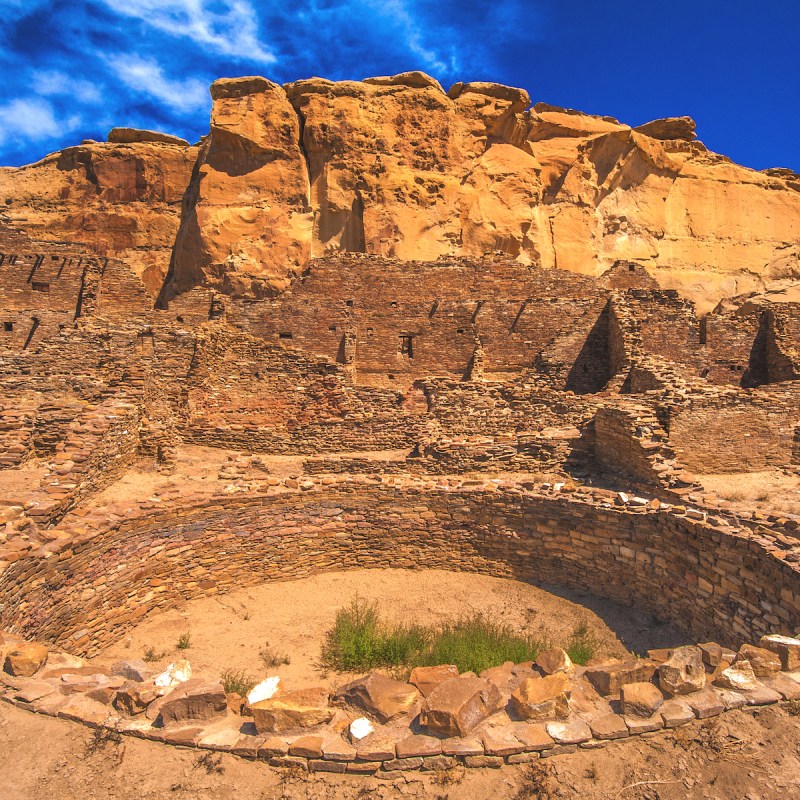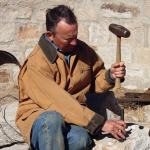
I camped near a shallow wash on the border of Colorado and New Mexico. My small sagebrush fire cast a pale glow into the growing twilight. Nighttime in the high desert is both fascinating and a bit scary. Nocturnal creatures emerge and the spirits of the old ones seem close.
Videos by TravelAwaits
The next day, I would strike out for Chaco Culture National Historical Park, often called Chaco Canyon, a place I’ve waited many years to see again. In the morning, I left the paved highway near the Nageezi trading post and headed for the park. A freezing rain pelted my pickup and dark gray clouds hung low over the mesas. The sleet gave way to a driving snow as I descended into the canyon.

The Beginning
I first visited Chaco in the summer of 1986 after leaving an unfulfilling job in search of a different career path. I learned about it from a friend who visited the site and spoke of its remoteness and solitude. For years, I had explored out-of-the-way places in the Southwest, but now, after learning of this mysterious national park, my spirit of adventure was rekindled.
I decided that, not only would I travel there, I would see about getting a job at the park. After researching the job postings for national park employment, I applied and discovered my three college semesters studying history and archaeology qualified me for a summer job as an archaeological assistant at the park. During the next two summers, I worked on several projects and gained insight into the lives of these ancient and mysterious people who, for thousands of years, eked out an existence in this bleak, northern New Mexico country.
Those two summers gave me a rare opportunity to work on projects designed to protect the park’s resources and, as a special treat, to visit remote sites far off the beaten path. Working at Chaco fulfilled my long-dormant dream of becoming a National Park Service ranger. I had found my bliss! Over the next 25 years, I had the good fortune to work at seven national parks and monuments before retiring several years ago. It was an exhilarating experience and one I’ll always cherish.

The Chaco Saga Begins
It was here in a wide, shallow canyon that a culture we now call Ancestral Puebloan developed, flourished, and withered away under a harsh, desert sun. The story at Chaco represents a 10,000-year gradual progression from nomadic hunter-gatherers to more sedentary farmers and artists. For centuries, the people, traveling on ancient migration routes, hunted animals and gathered seeds for food. Over time, they acquired skills as farmers, master stone masons, and most importantly, leaders in the establishment of the canyon as an economic, trading, and spiritual center for the entire region. Artifacts found at Chaco show a trade network extending west to the Pacific Coast and as far south as Central America.
Around 500 C.E. (formerly termed A.D.), the cultivation of crops arose and greatly reduced their need to hunt and gather. In 900 C.E., in a burst of cultural florescence, they began constructing great cities. They quarried sandstone blocks to build a dozen stone cities in a 9-mile arc across the central portion of the canyon. This high-density cluster represents the zenith of their architectural mastery. Over 400 miles of well‑engineered roads connected these cities to 75 smaller town sites. The ruins of multi-story communities at Penasco Blanco, Chetro Ketl, Pueblo Bonito, and others bear mute testimony to the intricate craftsmanship of these desert dwellers.
Pueblo Bonito, perhaps the greatest, freestanding masonry structure ever constructed in North America until the 18th century, contained over 800 rooms and rose, in a stair-step fashion, to a height of five stories. Carefully designed and constructed between C.E. 850 and 1150, Bonito is the finest example of the unique Chacoan architecture.

The Glory Fades
Today, it’s hard to imagine as you look at its crumbled walls, its rooms choked with weeds and dust, that this was once the crown jewel of a magnificent empire. At their peak, the Ancestral Puebloan culture created Bonito and other great cities as monuments to the glories of their civilization.
The Chaco People were farmers in a harsh land. Rainfall averages a scant 10 inches per year with most falling during severe, late‑summer thunderstorms. They designed intricate water-management systems to irrigate crops of corn, beans, and squash on the canyon floor.
Despite these advances, the winds of change would sweep across the canyon and forever alter their way of life. Although they were masters at desert agriculture, a prolonged drought from 1130–1190 ended their agricultural experiment in the desert as they slowly succumbed to an ever-changing climate. Compared to the measured rise of their culture, its end was swift.
After 1150, construction of new buildings ceased and the people abandoned their magnificent cities and dispersed throughout the region. By 1250, the collapse of the Ancestral Puebloan culture at Chaco Canyon was complete.
Their innovations in agriculture, architecture, and social organization are models for modern society. But, in the end, they stripped the scattered trees from the land for building materials and fuel, lowered the water table by neglecting to control gully erosion, and depleted the native plants and animals to feed the population. Once again, they became nomads to complete the great circle from which they began.

Reflections On Revisiting
During my recent visit, I hiked to an outlying site called Wijiji. While working at Chaco, I often went there to meditate within this ancient culture. There was something both exciting and disquieting about Wijiji. On a visit years before, as I sat against its ancient wall, I heard strange voices and felt a presence that sent chills up my spine. I can’t explain what happened to me that day but I still shiver when remembering that feeling.
This time, I was also spooked by what I thought was something moving throughout one of the room blocks at Wijiji. It was dusk and my rational mind rejected what I had just seen, but the imagination works on a level beyond logical thought. While hiking back, I pondered what had happened and thought of the world that lies beyond our rational minds. It’s a place of images and ghosts that defy definition. Once again, the magic of Chaco had come to me.
On my last night at Chaco, I stood in a shower of moonlight amid the deserted room blocks of Pueblo Bonito. I wondered about its ancient inhabitants. Did they, like us, believe their great cities and their glorious civilization would last forever?
The months I’d spent at Chaco years ago convinced me that the spirits of the Ancestral Puebloans still dwell in this most hallowed place. When you visit Chaco, take time to relax, to savor the magic of the desert. With a gentle wind and a bright moon overhead, unhook your logical mind and listen — you may hear strange voices carried on the evening breeze.
The stark beauty of these ancient ghost towns will heighten your spirit of adventure and rekindle the priceless sense of imagination so often lost in the passage from childhood to adulthood.
Read more on visiting Chaco Culture National Historical Park.
